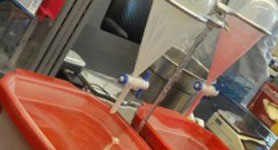By Emily Del Bel
The Food Technology Industrial Achievement Award has been awarded by the Institute of Food Technologists since 1959. According to their website, the Food Technology Industrial Achievement Award is awarded to “honor a company or organization for an outstanding development which represents a significant advance in the application of food science and technology to food production.” Notable past award winners include the USDA for the process to manufacture potato flakes, General Foods for the product now known as Cool Whip, Kelco Company and the USDA for Xanthan Gum, and McNeil Specialty Products for Sucralose.
I was recently assigned the task of reviewing past IFT industrial Achievement Award winners for a class and writing a one-page report about an achievement of my choice. I chose to research the development of the enzyme that is the key ingredient in the product Lactaid. The Eastern Regional Research Center, USDA/ARS and Lactaid, Inc. were awarded an IFT Industrial Achievement Award in 1987 for an “enzyme that reduces lactose into simpler sugars so that milk products can be ingested by lactose-intolerant individuals”.
A scientist who worked at the USDA Agricultural Research Service by the name of Virginia Harris Holsinger was the primary investigator on research that led to the invention of this enzyme. She was a chemist by training who specialized in dairy products. Alan Kligerman was a third generation dairyman who founded the company that eventually became Lactaid Inc. In the early 1980’s Mr. Kligerman approached Ms. Holsinger about developing a milk substitute for lactose intolerant individuals. Ms. Holsinger developed a process using fungi-produced lactase to break down a significant amount of the disaccharide lactose into its respective monosaccharide components: glucose and galactose. This process was used in the development of Lactaid brand milk and dietary supplements. Lactaid Inc. was sold to Johnson and Johnson in 1991 and Lactaid, according to AkPharma’s website, has gone on to become the number one selling branded milk since 2001. This process has since been modified to be applied to ice cream, powdered milk for lactose intolerant military personnel, and in my opinion has earned the right to be called one of the top industrial achievements of the last 50 years.
Looking through the list of past winners made me realize how many advances have been made in the food industry in the last 50 years, and how lucky I am to live in a time and place where food is plentiful (if not everywhere), safe (even if it’s not perfect), and affordable (if not downright cheap). There are a number of innovations on this list that have been targeted as “what’s wrong with the food industry these days”, but I would argue that this list represents the achievements of the food industry to make food into something that people want. The food industry has been charged with the nearly impossible task to make food delicious, safe, fast, affordable, healthy, portable, low calorie, or all of the above, even though many of them are conflicting at best and impossible at worst. Even though it’s impossible to satisfy everyone, I think that it could be said that this list represents the best attempts of the food industry to try and do so.
What do you think that the most influential industrial achievement in the last 50 years has been? Do you think this list captures them all? Share your thoughts in the comments below.
Photo Credit: http://commons.wikimedia.org/wiki/File%3AMilk_glass.jpg
Photo by Stefan Kühn (Own work)






I am always amazed at how far food safety has come in recent years. HACCP, for example wasn’t implemented in the food industry until the 1970’s. Today it is the standard food safety system used by pretty much everyone. Sanitation also wasn’t much of a concern but the industry has come leaps and bounds from where it was. We still have a way to go before food is 100% safe but there has been a lot of progress in recent years.